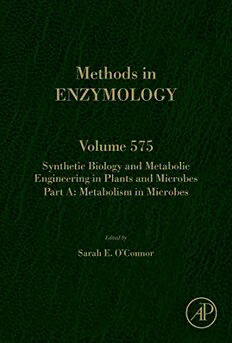
Synthetic Biology and Metabolic Engineering in Plants and Microbes Part A: Metabolism in Microbes PDF
Preview Synthetic Biology and Metabolic Engineering in Plants and Microbes Part A: Metabolism in Microbes
METHODS IN ENZYMOLOGY Editors-in-Chief ANNA MARIE PYLE Departments of Molecular, Cellular and Developmental Biology and Department of Chemistry Investigator, Howard Hughes Medical Institute Yale University DAVID W. CHRISTIANSON Roy and Diana Vagelos Laboratories Department of Chemistry University of Pennsylvania Philadelphia, PA Founding Editors SIDNEY P. COLOWICK and NATHAN O. KAPLAN AcademicPressisanimprintofElsevier 50HampshireStreet,5thFloor,Cambridge,MA02139,UnitedStates 525BStreet,Suite1800,SanDiego,CA92101–4495,UnitedStates TheBoulevard,LangfordLane,Kidlington,OxfordOX51GB,UnitedKingdom 125LondonWall,London,EC2Y5AS,UnitedKingdom Firstedition2016 Copyright©2016ElsevierInc.Allrightsreserved. Nopartofthispublicationmaybereproducedortransmittedinanyformorbyanymeans, electronicormechanical,includingphotocopying,recording,oranyinformationstorageand retrievalsystem,withoutpermissioninwritingfromthepublisher.Detailsonhowtoseek permission,furtherinformationaboutthePublisher’spermissionspoliciesandour arrangementswithorganizationssuchastheCopyrightClearanceCenterandtheCopyright LicensingAgency,canbefoundatourwebsite:www.elsevier.com/permissions. Thisbookandtheindividualcontributionscontainedinitareprotectedundercopyrightby thePublisher(otherthanasmaybenotedherein). Notices Knowledgeandbestpracticeinthisfieldareconstantlychanging.Asnewresearchand experiencebroadenourunderstanding,changesinresearchmethods,professionalpractices, ormedicaltreatmentmaybecomenecessary. Practitionersandresearchersmustalwaysrelyontheirownexperienceandknowledgein evaluatingandusinganyinformation,methods,compounds,orexperimentsdescribed herein.Inusingsuchinformationormethodstheyshouldbemindfuloftheirownsafetyand thesafetyofothers,includingpartiesforwhomtheyhaveaprofessionalresponsibility. Tothefullestextentofthelaw,neitherthePublishernortheauthors,contributors,oreditors, assumeanyliabilityforanyinjuryand/ordamagetopersonsorpropertyasamatterof productsliability,negligenceorotherwise,orfromanyuseoroperationofanymethods, products,instructions,orideascontainedinthematerialherein. ISBN:978-0-12-804584-8 ISSN:0076-6879 ForinformationonallAcademicPresspublications visitourwebsiteathttps://www.elsevier.com/ Publisher:ZoeKruze AcquisitionEditor:ZoeKruze EditorialProjectManager:SarahLay ProductionProjectManager:MageshKumarMahalingam CoverDesigner:MariaInesCruz TypesetbySPiGlobal,India CONTRIBUTORS L.M.Alkhalaf UniversityofBritishColumbia,Vancouver,BC,Canada M.C.Andorfer UniversityofChicago,Chicago,IL,UnitedStates L.Bourgeois CentreforStructuralandFunctionalGenomics,ConcordiaUniversity,Montr(cid:1)eal,QC, Canada E.Burton CentreforStructuralandFunctionalGenomics,ConcordiaUniversity,Montr(cid:1)eal,QC, Canada L.Chang UniversityofCalgary,Calgary,AB,Canada X.Chen UniversityofCalgary,Calgary,AB,Canada R.E.Cobb UniversityofIllinoisatUrbana-Champaign,Urbana,IL,UnitedStates;CarlR.Woese InstituteforGenomicBiology,UniversityofIllinoisatUrbana-Champaign,Urbana,IL, UnitedStates S.D.Colloms UniversityofGlasgow,Glasgow,UnitedKingdom M.Dastmalchi UniversityofCalgary,Calgary,AB,Canada Y.-L.Du UniversityofBritishColumbia,Vancouver,BC,Canada S.Edgar MassachusettsInstituteofTechnology,Cambridge,MA,UnitedStates P.J.Facchini UniversityofCalgary,Calgary,AB,Canada E.Fossati CentreforStructuralandFunctionalGenomics,ConcordiaUniversity,Montr(cid:1)eal,QC, Canada M.Gajewi AllgemeineBiochemie,TUDresden,Dresden,Germany J.M.Gardiner SchoolofChemistry,ManchesterInstituteofBiotechnology,UniversityofManchester, Manchester,UnitedKingdom xi xii Contributors N.D.Gold CentreforStructuralandFunctionalGenomics,ConcordiaUniversity,Montr(cid:1)eal,QC, Canada J.M.Hagel UniversityofCalgary,Calgary,AB,Canada L.Humphreys GlaxoSmithKline,MedicinesResearchCentre,Stevenage,UnitedKingdom A.Jervis ManchesterInstituteofBiotechnology,SYNBIOCHEM,UniversityofManchester, Manchester,UnitedKingdom J.A.Jones RensselaerPolytechnicInstitute,Troy,NY,UnitedStates;CenterforBiotechnologyand InterdisciplinarySciences,RensselaerPolytechnicInstitute,Troy,NY,UnitedStates M.A.G.Koffas RensselaerPolytechnicInstitute,Troy,NY,UnitedStates;CenterforBiotechnologyand InterdisciplinarySciences,RensselaerPolytechnicInstitute,Troy,NY,UnitedStates J.C.Lewis UniversityofChicago,Chicago,IL,UnitedStates J.Li UniversityofCalgary,Calgary,AB,Canada W.Liu StateKeyLaboratoryofBioorganicandNaturalProductsChemistry,ShanghaiInstitute ofOrganicChemistry,ChineseAcademyofSciences,Shanghai;HuzhouCenterof Bio-SyntheticInnovation,Huzhou,PRChina V.J.J.Martin CentreforStructuralandFunctionalGenomics,ConcordiaUniversity,Montr(cid:1)eal,QC, Canada D.Medina-Stacey SchoolofChemistry,ManchesterInstituteofBiotechnology,TheUniversityofManchester, Manchester,UnitedKingdom C.A.Merrick UniversityofEdinburgh,Edinburgh,UnitedKingdom J.Micklefield SchoolofChemistry;CentreforSyntheticBiologyofFineandSpecialityChemicals (SYNBIOCHEM),ManchesterInstituteofBiotechnology,TheUniversityofManchester, Manchester,UnitedKingdom D.Milbredt AllgemeineBiochemie,TUDresden,Dresden,Germany J.S.Morris UniversityofCalgary,Calgary,AB,Canada Contributors xiii A.N´ıCheallaigh SchoolofChemistry,ManchesterInstituteofBiotechnology,UniversityofManchester, Manchester,UnitedKingdom L.Narcross CentreforStructuralandFunctionalGenomics,ConcordiaUniversity,Montr(cid:1)eal,QC, Canada J.E.Paget UniversityofEdinburgh,Edinburgh,UnitedKingdom B.Pang StateKeyLaboratoryofBioorganicandNaturalProductsChemistry,ShanghaiInstituteof OrganicChemistry,ChineseAcademyofSciences,Shanghai,PRChina E.P.Patallo AllgemeineBiochemie,TUDresden,Dresden,Germany J.T.Payne University of Chicago, Chicago, IL; Stanford University, Stanford, CA, United States M.E.Pyne CentreforStructuralandFunctionalGenomics,ConcordiaUniversity,Montr(cid:1)eal,QC, Canada C.J.Robinson SchoolofChemistry;CentreforSyntheticBiologyofFineandSpecialityChemicals (SYNBIOCHEM),ManchesterInstituteofBiotechnology,TheUniversityofManchester, Manchester,UnitedKingdom S.J.Rosser UniversityofEdinburgh,Edinburgh,UnitedKingdom K.S.Ryan UniversityofBritishColumbia,Vancouver,BC,Canada D.Sardar UniversityofUtah,SaltLakeCity,UT,UnitedStates E.W.Schmidt UniversityofUtah,SaltLakeCity,UT,UnitedStates N.S.Scrutton ManchesterInstituteofBiotechnology,FacultyofLifeSciences,UniversityofManchester, Manchester,UnitedKingdom G.Stephanopoulos MassachusettsInstituteofTechnology,Cambridge,MA,UnitedStates S.Tait ManchesterInstituteofBiotechnology,FacultyofLifeSciences,UniversityofManchester, Manchester,UnitedKingdom xiv Contributors E.Takano ManchesterInstituteofBiotechnology,FacultyofLifeSciences,UniversityofManchester, Manchester,UnitedKingdom Z.Tang StateKeyLaboratoryofBioorganicandNaturalProductsChemistry,ShanghaiInstituteof OrganicChemistry,ChineseAcademyofSciences,Shanghai,PRChina M.D.Tianero UniversityofUtah,SaltLakeCity,UT,UnitedStates H.S.Toogood ManchesterInstituteofBiotechnology,FacultyofLifeSciences,UniversityofManchester, Manchester,UnitedKingdom J.W.A.vanDijk SchoolofPharmacy,UniversityofSouthernCalifornia,LosAngeles,CA,UnitedStates K.-H.vanP(cid:1)ee AllgemeineBiochemie,TUDresden,Dresden,Germany H.A.Vincent SchoolofChemistry,ManchesterInstituteofBiotechnology,TheUniversityofManchester, Manchester,UnitedKingdom C.C.C.Wang SchoolofPharmacy;DornsifeCollegeofLetters,Arts,andSciences,UniversityofSouthern California,LosAngeles,CA,UnitedStates Y.Wang UniversityofIllinoisatUrbana-Champaign,Urbana,IL,UnitedStates C.Wardrope UniversityofEdinburgh,Edinburgh,UnitedKingdom V.Weichold AllgemeineBiochemie,TUDresden,Dresden,Germany M.-C.Wu SchoolofChemistry,ManchesterInstituteofBiotechnology,TheUniversityofManchester, Manchester,UnitedKingdom H.Zhao UniversityofIllinoisatUrbana-Champaign,Urbana,IL,UnitedStates;CarlR.Woese InstituteforGenomicBiology,UniversityofIllinoisatUrbana-Champaign,Urbana,IL, UnitedStates G.Zhong StateKeyLaboratoryofBioorganicandNaturalProductsChemistry,ShanghaiInstituteof OrganicChemistry,ChineseAcademyofSciences,Shanghai,PRChina K.Zhou NationalUniversityofSingapore,Singapore,Singapore PREFACE Advancesinsequencing,bioinformatics,and genomeeditingnowenableus toaccesstherichchemistryencodedwithinthemetabolicpathwaysofplants and microbes. A major focus in metabolism is the secondary, or specialized, pathways that produce small, biologically active molecules with applications inpharmaceutical,agrochemical,orotherbiotechnologicalsectors.Inrecent years, metabolic engineering/synthetic biology approaches have shown remarkable promise for the exploitation of these pathways for human use. Inthesetwovolumes,wehighlightsome ofthemost important approaches that have been used to harness microbial and plant metabolic pathways. In Volume 1, we focus on advances that have been made in microbial- basedsystems.Thediscoverysomethreedecadesagothatbacterialspecial- izedmetabolicpathwaysareclusteredonthegenomehasgreatlyfacilitated the identification and characterization of these pathway genes. Coupled withthefactthatbacterialgenomescannowbesequencedrapidlyandinex- pensively,thelastdecadehasseenastaggeringincreaseinourknowledgeof bacterial specialized metabolism. Additionally, it is now known that fungal specializedpathwaysalsoclusteronthegenome.Whilefungalgenomesare larger than those from bacteria, these genomes can still can be easily sequenced, and substantial advances in elucidating fungal metabolism have beenmade.Consequently,awealthofnewopportunitiesinmetabolicengi- neeringhavebeenopened.Inthisvolume,wehighlighthowbetterproduc- tion of these compounds can be achieved, and how these biosynthetic enzymescanbeengineeredtogeneratenewbiocatalystsandnewproducts. Wealsodiscusshowmicrobialspeciescanbemanipulatedtoserveasahost for reconstitution of plant pathways. The volume concludes with several representative examples of new tools that allow us to rapidly manipulate the genetic material of the microbial host. Volume2focusesonthemetabolismofplants.Historically,elucidating plant metabolism has been challenging due to the lack of tightly genome- clustered pathways that are observed in microbial systems, along with the large size of plant genomes and transcriptomes. The first set of articles in this volume describe a variety of strategies to elucidate plant-specialized metabolism. Notably, the specialized metabolism of plants is controlled bycomplexregulatoryprocesses.Furthermore,plantbiosyntheticprocesses are also complicated by the fact that the metabolic reactions occur in a xv xvi Preface variety of different cell types and subcellular compartments. Therefore, several articles in thisvolume alsodescribe effortsto control the regulatory networksthatmaintainthelevelsofmetabolismproductioninplants,along withmethodstounderstandthemechanismsoftransportandlocalizationof specialized metabolic intermediates. Finally, we highlight emerging tools to harness plant metabolism: new plant-based expression platforms and expression tools for production of metabolites are discussed. Metabolic engineering has progressed rapidly in the last several years. The advent of genome editing, the ability to sequence complex genomes quickly and inexpensively, and the successful manipulation of plant and microbial hosts for moreeffectivepathway reconstitutionhave collectively demonstrated that metabolic engineering holds substantial promise for improving our access to the end products of specialized metabolism. Inotethatthesetwovolumesscratchthesurfaceofthisfield,providingonly asurveyofsomeoftheeffortsbeingmadeinthisarea.Iamdeeplyindebted toallofthecontributorstothisvolumewhograciouslyprovidedtheirtime and effort to make a contribution to this work. S.E. O’CONNOR The John Innes Centre Department of Biological Chemistry CHAPTER ONE Directing Biosynthesis: Practical Supply of Natural and Unnatural Cyanobactins D. Sardar, M.D. Tianero, E.W. Schmidt1 UniversityofUtah,SaltLakeCity,UT,UnitedStates 1Correspondingauthor:e-mailaddress:[email protected] Contents 1. Introduction 1 2. DiscoveryofCyanobactinPathways 2 3. ElucidatingNaturalRulesofEngineeringinCyanobactinPathways 3 4. HeterologousExpressionofCyanobactinPathwaysinE.coli 5 5. OptimizationforIncreasedYieldofCyanobactinsinE.coli 9 6. SynthesisofCyanobactinsInVitro 11 7. Conclusions 16 8. Outlook 18 Acknowledgments 18 References 18 Abstract Theincreasinglyrapidaccumulationofgenomicinformationisrevolutionizingnatural products discovery. However, the translation of sequence data to chemical products remainsachallenge.Here,wedetailmethodsusedtocircumventthesupplyproblem ofcyanobactinnaturalproducts,bothbyengineeredsynthesisinEscherichiacoliandby usingpurifiedenzymesinvitro.Suchmethodologiesexploitnature'sstrategiesofcom- binatorialchemistryinthecyanobactinclassofRiPPnaturalproducts.Asaresult,itis possibletosynthesizeawidevarietyofnaturalandunnaturalcompounds. 1. INTRODUCTION Naturalproductsremainamajorcomponentofdrugdiscoveryefforts (Newman&Cragg,2012),butsucheffortsarestillhinderedbytheneedto synthesizeasufficientsupplyandtocreateanalogs.Mimickingbiosynthesis has emerged as a powerful tool to overcome these problems, providing a tractable alternative to traditional chemical synthesis. The key advance MethodsinEnzymology,Volume575 #2016ElsevierInc. 1 ISSN0076-6879 Allrightsreserved. http://dx.doi.org/10.1016/bs.mie.2016.02.012 2 D.Sardaretal. thathasaidedthisistheexplosioningenomicdata,whichhasallowedcon- nectingnaturalproductstotheircorrespondinggenes(Walsh&Fischbach, 2010).Inturn,rapidgeneidentificationenablesheterologousexpressionof enzymestoperformtotalsynthesisinvivoorinvitro.Connectinggenesto molecules has thus aided discovery based on sequencing, overcoming limitations of conventional natural products discovery, which relies on actual physical isolation of compounds, often from far-reaching locations of the earth. In addition, assigning genes to specific chemical modifica- tions allows exploitation of enzyme function to modify nature’s arsenal of chemistry far beyond, by technologies such as directed evolution (Renata, Wang, & Arnold, 2015). Thischapterfocusesondirectingbiosynthesisusingthecyanobactinbio- synthetic machinery to engineer synthesis. Cyanobactins are natural prod- ucts found in marine animals or in relatively slow-growing cyanobacteria. Duetotherareandvariabledistributionoftheproducingorganisms,supply isanissuehinderingcyanobactindevelopment.Anadvantageisthatseveral cyanobactin pathways are exceptionally broad-substrate tolerant, which allows cyanobactin enzymes and pathways to be used in the synthesis of thousands of derivatives. Recent advances enable such synthesis at scale in Escherichia coli and in vitro using purified enzymes. Later, we describe methods enabling the practical synthesis and engineering of cyanobactin pathways. 2. DISCOVERY OF CYANOBACTIN PATHWAYS ThecyanobactinsbelongtoRiPP(ribosomallysynthesizedandpost- translationallymodifiedpeptides)classofnaturalproductsandarepresentin about 30% of all cyanobacteria (Arnison et al., 2013; Sivonen, Leikoski, Fewer, & Jokela, 2010). The first cyanobactins, patellamides, were isolated from marine ascidian animals (Ireland & Scheuer, 1980), and related com- poundshavealsobeenfoundinbothascidiansandfree-livingcyanobacteria. Subsequently,biosyntheticgenesforcyanobactinswerediscovered.Asmall sample (several grams) of the ascidian Lissoclinum patella was obtained near breaking surf on the reef flat above Blue Corner, Palau. Metagenome sequencingofthemarineanimalanditssymbioticbacterialedtoidentifica- tionofaRiPPpathway,patinsymbioticcyanobacteria,Prochloron.patcar- riedageneencodingtheaminoacidsequenceofpatellamide.Heterologous expressionofpatinE.coliconfirmedthesymbiontProchloronasthesourceof
